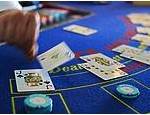

Jun
27
2011
The Number of Decks in Blackjack
By John Grochowski on Monday June 27, 2011
blackjack, gaming, gaming-strategy, tourism, tunica

On a casino trip with my dad Jerry and my brother Jay, we were scouting blackjack tables. We bypassed a single-deck game that paid only 6-5 on blackjacks, then chose a two-deck game over a six-decker.
Over dinner that night, Jay had a question.
“Why are fewer decks better?” he asked. “I get that you have to account for the other rules. But if everything else is the same, what is it about fewer decks that make it better?”
The key is the effect of card removal on the composition of the remaining deck. Removing one card from a single deck changes the percentages in a single-deck more than it changes a six-deck pack. That effect means we get more blackjacks and double downs play truer with fewer decks.
Let’s say the first card we’re dealt is an Ace. In a single deck game, 16 of the other 51 cards are 10 values. That means 31.37 percent of the remaining cards will complete the blackjack. If six decks are in play, removing an Ace means 96 of the remaining 311 cards are 10-values. That’s 30.87 percent, meaning we have a lesser chance of completing our blackjack in a six-deck game than in a single-deck game.
It works the other way, too. If our first card is a 10 value, 7.84 percent of the remaining cards are Aces in a single-deck game, while 7.72 percent are Aces in a six-deck game.
Double downs? Start with 6-5, for example, and 32 percent of the other cards are 10s in single-deck blackjack, and 30.97 percent in six-deck games.
The proportion of cards are the same regardless of number of decks only immediately after a shuffle. Once cards are dealt, the percentages change more rapidly with fewer decks in play.
